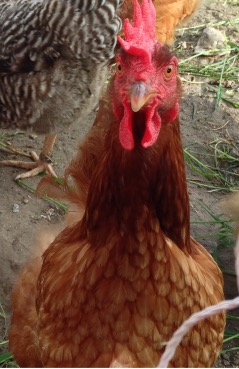Are Your Chickens Cool Enough to Beat the Heat?
go.ncsu.edu/readext?867413
en Español / em Português
El inglés es el idioma de control de esta página. En la medida en que haya algún conflicto entre la traducción al inglés y la traducción, el inglés prevalece.
Al hacer clic en el enlace de traducción se activa un servicio de traducción gratuito para convertir la página al español. Al igual que con cualquier traducción por Internet, la conversión no es sensible al contexto y puede que no traduzca el texto en su significado original. NC State Extension no garantiza la exactitud del texto traducido. Por favor, tenga en cuenta que algunas aplicaciones y/o servicios pueden no funcionar como se espera cuando se traducen.
Português
Inglês é o idioma de controle desta página. Na medida que haja algum conflito entre o texto original em Inglês e a tradução, o Inglês prevalece.
Ao clicar no link de tradução, um serviço gratuito de tradução será ativado para converter a página para o Português. Como em qualquer tradução pela internet, a conversão não é sensivel ao contexto e pode não ocorrer a tradução para o significado orginal. O serviço de Extensão da Carolina do Norte (NC State Extension) não garante a exatidão do texto traduzido. Por favor, observe que algumas funções ou serviços podem não funcionar como esperado após a tradução.
English
English is the controlling language of this page. To the extent there is any conflict between the English text and the translation, English controls.
Clicking on the translation link activates a free translation service to convert the page to Spanish. As with any Internet translation, the conversion is not context-sensitive and may not translate the text to its original meaning. NC State Extension does not guarantee the accuracy of the translated text. Please note that some applications and/or services may not function as expected when translated.
Collapse ▲Summer heat and humidity is upon us and we’re all looking for ways to cool off. Your backyard feathered friends are no exception. This article outlines a few signs that your poultry could be experiencing heat stress and what you can do about it. Let’s dive on in!
An experienced chicken keeper knows their flock, their personalities and habits. This type of relationship provides you quick insight into changes in flock disposition that can be an early sign that something is a little off. This can be a result of disease or other stressors that can decrease production, cause unnecessary stress and fatigue, or even mortality. Although all flocks and flock members will behave a little differently under normal circumstances, there are some obvious signs that your birds could be experiencing heat stress.
- panting / labored breathing
- holding wings out and away from the body
- pale combs and wattles
- decrease in egg production
- decrease in normal activity, energy, or enthusiasm
- loose fecal droppings
If your birds are exhibiting these symptoms, it’s important to take immediate action. And even if they’re not, the following are good precautionary measures to prevent heat stress in your flock.
Keep your birds hydrated! Be sure that fresh clean water is readily available and kept in a cool shady area. If water consumption is decreased, adding electrolytes can be a good way to boost water intake and reduce dehydration. Electrolytes can be purchased in various forms, but are most often found in water soluble powders that tend to mix easily with your water source. Be sure to follow the product’s label when mixing as a highly diluted solution will not provide necessary intake and an over concentrated solution may actually cause birds to drink less.
Additionally, be sure to minimize the effects of radiant heat. If your coop is mobile, relocate it to shady area with good ventilation. If your coop is stationary, look for ways to encourage air movement by opening any and all vents in the structure. If you have an electrical supply nearby, adding a fan can be a nice touch. We all know the value of a good breeze on a hot summer day.
If your birds free range or your coop has an outside run, be sure they have access to shady areas. Placing feeders and drinkers in those areas can encourage them to spend more time out of direct sunlight. You can also place temporary roosts or other forms of enrichment in these areas. If there isn’t any natural shade in your run, consider providing some temporarily until the fall when cooler weather returns. Think pop up tent, tarps, shade cloth, etc.
Summertime can also be a good opportunity to change out older deep bedding that may be acting as compost and a heat source. New bedding will be less compacted and facilitate the escape of excess body heat. Selecting a bedding that is a little more coarse in nature for summer months, shavings instead of sawdust for example, will also allow for more air space and facilitate natural air flow.
If you have exhausted all of the above, and your birds are still exhibiting signs of heat stress, moisture can do the trick. You can add misters in areas that the birds frequent or lightly dampen the ground with a water hose in common areas to encourage evaporative cooling. Some producers may even find it beneficial to add small wading pools with shallow water for the birds to access, but not all feathered friends will be a fan of this feature.
Now that you know the signs of heat stress and what you can do about it, make sure you take the necessary steps to ensure the health and welfare of your feathered friends. If you need additional help with any of your poultry needs, please don’t hesitate to reach out to your local Poultry ASA.




